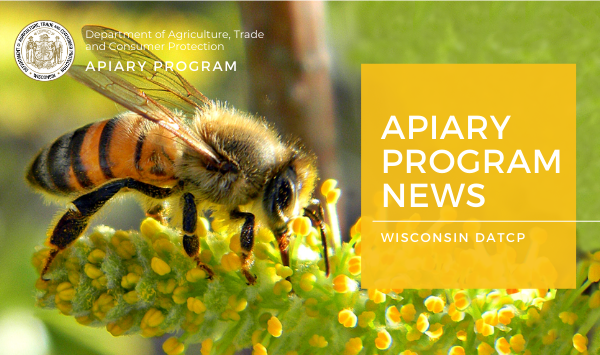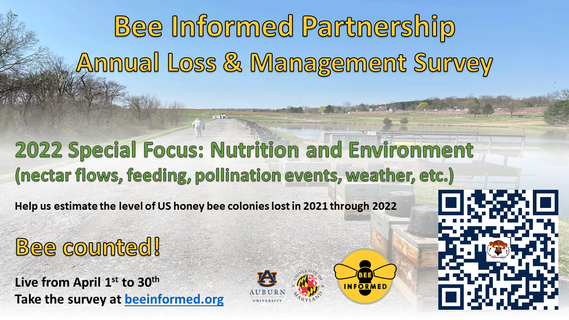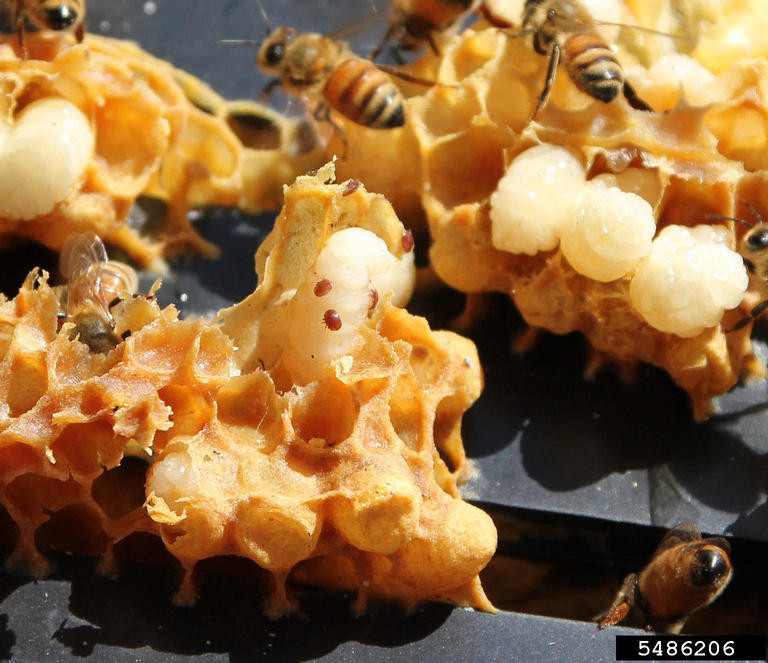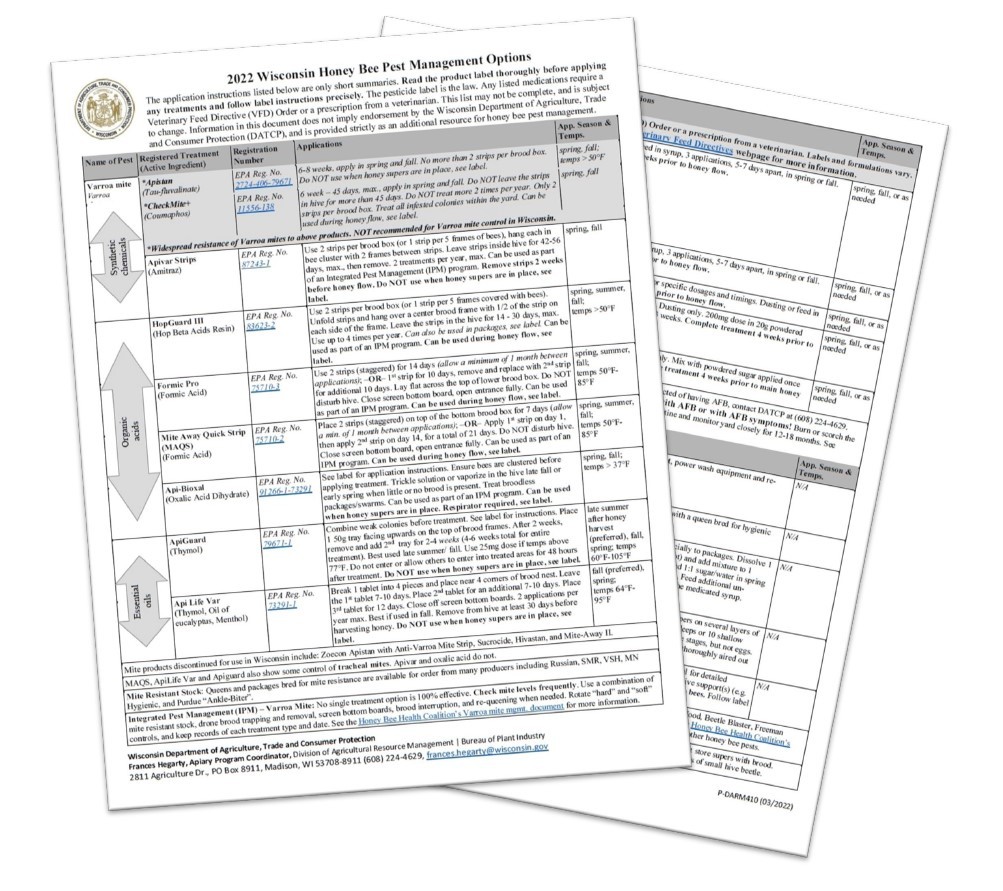
Dear Wisconsin beekeepers and those interested in honey bees and wild pollinators:
This is the second quarterly update from the Wisconsin Department of Agriculture, Trade and Consumer Protection’s (DATCP) apiary program. Please let us know how you utilize this newsletter and send any feedback, questions, or ideas for future updates to Frances.Hegarty@wisconsin.gov.
The DATCP Beekeeping and Pollinators webpage contains links to webpages for the DATCP Apiary Program and the Wisconsin Pollinator Protection Plan.
The Bee Informed Partnership, in cooperation with the University of Maryland, and Auburn University has opened their annual Loss and Management Survey until April 30 and requests your participation. The purpose of the survey is to document honey bee colony losses and related beekeeping management practices in U.S. operations on an annual basis. This year’s focus is on nutrition and environment. If you are a beekeeper, please consider taking this survey by April 30 to provide important information related to honey bee management and colony loss.
 Take the survey at https://beeinformed.org/take-survey/.
Varroa mites (Varroa destructor) are one of the most serious and costly honey bee pests in the country. Research by scientists at the U.S. Department of Agriculture’s Agricultural Research Service (USDA ARS) and the University of Maryland in 2019 found that Varroa mites feed on honey bees' fat body tissue (an organ similar to the human liver), rather than the hemolymph as previously thought. This feeding weakens the bees, can lead to substantial bee mortality, and can vector other serious diseases, including viruses.
Varroa mites are now so widespread in the U.S. that all beekeepers in the U.S. should assume that their honey bees have Varroa mites. However, each beekeeper should be monitoring and tracking the Varroa mite levels in their colonies to understand which Integrated Pest Management (IPM) steps to take during the year. See pages 7-9 of the Honey Bee Health Coalition’s Tools for Varroa Management - A Guide to Effective Varroa Sampling and Control, 2018 for sampling and monitoring suggestions. In addition to this guide, The Honey Bee Health Coalition has additional tools for Varroa mite management on their website.
In other recent news, the USDA announced on April 7, 2022 that the USDA ARS developed Pol-line honey bees, a line of honey bees with high Varroa mite resistance and improved winter survival when compared to standard colonies. The Pol-line of honey bees’ high level of Varroa mite resistance is based on their trait called Varroa-sensitive hygiene (VSH). The Pol-line of honey bees remove Varroa mites by expelling infested pupae. Read more about this research here.
 Varroa mites on a honey bee drone pupa. Photo: Denise Ellsworth, The Ohio State University, Bugwood.org
Check the DATCP apiary program’s Pest & Disease Management of Honey Bees webpage each year for a list of approved honey bee treatments. Please read this updated 2022 list of honey bee pest management options. The treatment options listed in this document are an additional resource of short summaries and, if appropriate, could be part of an Integrated Pest Management (IPM) program for honey bees. Additionally, see pages 31-35 of the Honey Bee Heath Coalition’s Best Management Practices for Hive Health, 2019 for an introduction to IPM for honey bees. Read the product label thoroughly before applying any treatments and follow label instructions precisely. The pesticide label is the law. Report any pesticide misuse to DATCP at (608) 224-4529 or DATCPpesticideinfo@wisconsin.gov. Any listed medications require a Veterinary Feed Directive (VFD) order or a prescription from a veterinarian. If you have questions about VFD orders, contact DATCP at (608) 224-4539 or DATCPFeed@wisconsin.gov.
 The 2022 Wisconsin Honey Bee Pest Management Options document is available here.
Please welcome Donna Stine and Patrick Sizemore as returning DATCP apiary program inspectors. Donna and Patrick will be conducting apiary inspections on a full-time basis May – October. Limited package inspections are currently ongoing on a part-time basis. Starting in May, Donna will be serving as the apiary program inspector for Eastern Wisconsin and Patrick will be serving as the apiary program inspector for Western Wisconsin. See the DATCP Apiary (Beekeeping) Inspections webpage for the most current contact information for Donna and Patrick and what to expect during an inspection. The beekeeper needs to be present during the inspection. We look forward to seeing you and your honey bees!
 Inspector for Western Wisconsin (yellow) Patrick Sizemore; Inspector for Eastern Wisconsin (blue) Donna Stine. See our webpage for contact info.
If you have eight or more hives, please strongly consider taking part in the National Honey Bee Survey (NHBS). DATCP inspectors will take comprehensive samples of your live bees, bee bread, and wax (new this fall) in the early summer and fall. We need 19 participants this year. Samples are sent to the USDA ARS Bee Research Lab in Beltsville, MD, and samples are analyzed for pesticides residues at the USDA AMS National Science Lab in Gastonia, NC. It may take months to get your results back. This data is important to understanding honey bee health in the U.S. Data collected from the NHBS has helped understand geographical variations in viral, pest and pesticide loads. This data has become the baseline for honey bee disease levels in the U.S., valuable to beekeepers and researchers. All NHBS data is available to the public on the BIP Online Research Portal, summarized by state. The NHBS samples are free and done in addition to a DATCP beekeeper inspection. Please contact a DATCP apiary inspector to let us know if you are interested! Donna or Patrick may also approach you about becoming a 2022 NHBS participant during the course of regular inspections.
If you are reading this newsletter, did not receive it directly from DATCP, and would like to sign up for future quarterly installments, you can sign up here. Please enter your email address, click submit, and select the topic named “Honeybee (Apiary) Information” from the list. You may also select any other topics that interest you.
Find more information about the DATCP Apiary Program and the Wisconsin Pollinator Protection Plan via the DATCP Beekeeping and Pollinators webpage.
Division of Agricultural Resource Management | Bureau of Plant Industry
Having trouble viewing this email? View it as a Web page.
|